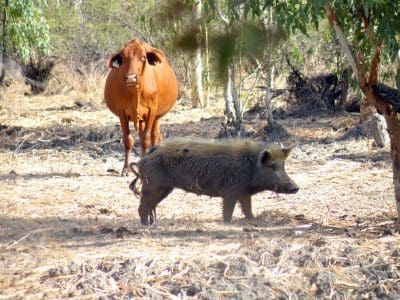A BIOSECURITY risk exercise has indicated there could be a 42 percent probability of a significant animal disease outbreak in Australia in the next five years.
The rapid structure expert judgement (SEJ) exercise facilitated by the Centre for Excellence for Biosecurity Risk Analysis last month has indicated concerning estimates of incursion risks for diseases of importance to sheep, goat, beef and horse producers.
 Participants in the SEJ session made private optimistic, pessimistic and ‘mostly likely’ projections of the probabilities of disease incursions, which were later aggregated.
Participants in the SEJ session made private optimistic, pessimistic and ‘mostly likely’ projections of the probabilities of disease incursions, which were later aggregated.
These included a 21pc risk of African Swine Fever, a 9pc risk of Foot and Mouth Disease, an 8pc risk of lumpy skin disease and a 13pc risk of African horse sickness, according to an information sheet from the session.
“Estimates from the exercise suggest that there could be a 42pc probability of an internationally-notifiable incursion of any one of these significant exotic diseases in Australia in the next 5 years.”
Australia’s Chief Veterinary Officer Mark Schipp last month spoke at an Animal Health Australia session that outlined the SEJ process, which is internationally recognised and used to obtain data on complex uncertain systems.
The information sheet said the SEJ process provides a systematic approach that minimises individual and group cognitive biases, surfaces assumptions and contextualises outcomes.
Sheep Producers Australia chief executive officer Stephen Crisp attended the AHA session and said the SEJ exercise outcomes have highlighted the need to address biosecurity reform in the sheep and goat sector as soon as possible.
He said the messages from the AHA session provided a sobering commentary on the probabilities of Australia suffering an incursion of an internationally notifiable disease within the next five years.
“What was interesting for the sheep sector is Foot and Mouth Disease rating 9pc.
“For a disease that would literally shut the trade doors, have a massive impact on stock and their producers, costing tens of billions of dollars, that number seems worryingly high,” he said.
The information sheet (click link below to access) outlined factors that are working in favour and against Australia’s biosecurity interests.
“One of the negatives, over which we have some level of control, is Biosecurity Complacency or Fatigue,” Mr Crisp said.
“This is one of the many reasons SPA has been pushing for the recent SAFEMEAT recommendations on biosecurity reform to be followed through.
“Australia must have an ability to both defend our shores and quickly bounce back from an incursion, or we risk being shut out of international markets for an extended time if our fears are realised,” he said.
“The SAFEMEAT recommendations do need to be looked at as soon as possible, because it is not just SPA or any one of the livestock industries looking at this, it’s everyone who is involved, from the government departments who presented at Animal Health Australia …. everyone is looking at it, so yes, it needs to be addressed.”
Sheep Producers Australia has called for a Federal Government decision on conducting a consultation Regulatory Impact Statement process to fully assess the impact of key livestock traceability recommendations to provide a fully costed decision paper to the Agriculture Ministers’ Forum AGMIN.
The recommendations supported by SPA, from an NLIS (Sheep & Goats) traceability evaluation, and presented by SAFEMEAT to the National Biosecurity Committee (NBC) in early 2020 were:
- Establishment of a regulatory or statutory entity responsible for managing Australian livestock traceability
- Investment into a database capable of handling all FMD susceptible livestock species,
- Mandating individual digital/electronic identification of livestock
- Creating an equitable funding arrangement for both the establishment and ongoing maintenance of the system, and
- A consultation Regulatory Impact Statement be conducted to fully assess the impact of these recommendations to provide a fully costed decision paper to AGMIN.
Click this link to access the information sheet, outlining factors that are working in favour and against Australia’s biosecurity interests.
